Using Smartphone TechnolOGy to Support an EffecTive Home ExeRcise Intervention to Prevent Falls amongst Community-Dwelling Older Adults: The TOGETHER Feasibility RCT
- PMID: 36470216
- PMCID: PMC10273876
- DOI: 10.1159/000528471
Using Smartphone TechnolOGy to Support an EffecTive Home ExeRcise Intervention to Prevent Falls amongst Community-Dwelling Older Adults: The TOGETHER Feasibility RCT
Erratum in
-
Erratum.Gerontology. 2023;69(11):1368. doi: 10.1159/000534435. Epub 2023 Oct 12. Gerontology. 2023. PMID: 37827128 Free PMC article. No abstract available.
Abstract
Introduction: Falls have major implications for quality of life, independence, and cost of health services. Strength and balance training has been found to be effective in reducing the rate/risk of falls, as long as there is adequate fidelity to the evidence-based programme. The aims of this study were to (1) assess the feasibility of using the "Motivate Me" and "My Activity Programme" interventions to support falls rehabilitation when delivered in practice and (2) assess study design and trial procedures for the evaluation of the intervention.
Methods: A two-arm pragmatic feasibility randomized controlled trial was conducted with five health service providers in the UK. Patients aged 50+ years eligible for a falls rehabilitation exercise programme from community services were recruited and received either (1) standard service with a smartphone for outcome measurement only or (2) standard service plus the "Motivate Me" and "My Activity Programme" apps. The primary outcome was feasibility of the intervention, study design, and procedures (including recruitment rate, adherence, and dropout). Outcome measures include balance, function, falls, strength, fear of falling, health-related quality of life, resource use, and adherence, measured at baseline, three-month, and six-month post-randomization. Blinded assessors collected the outcome measures.
Results: Twenty four patients were randomized to control group and 26 to intervention group, with a mean age of 77.6 (range 62-92) years. We recruited 37.5% of eligible participants across the five clinical sites. 77% in the intervention group completed their full exercise programme (including the use of the app). Response rates for outcome measures at 6 months were 77-80% across outcome measures, but this was affected by the COVID-19 pandemic. There was a mean 2.6 ± 1.9 point difference between groups in change in Berg balance score from baseline to 3 months and mean 4.4 ± 2.7 point difference from baseline to 6 months in favour of the intervention group. Less falls (1.8 ± 2.8 vs. 9.1 ± 32.6) and less injurious falls (0.1 ± 0.5 vs. 0.4 ± 0.6) in the intervention group and higher adherence scores at three (17.7 ± 6.8 vs. 13.1 ± 6.5) and 6 months (15.2 ± 7.8 vs. 14.9 ± 6.1). There were no related adverse events. Health professionals and patients had few technical issues with the apps.
Conclusions: The motivational apps and trial procedures were feasible for health professionals and patients. There are positive indications from outcome measures in the feasibility trial, and key criteria for progression to full trial were met.
Keywords: Older; Rehabilitation; Technology.
© 2022 The Author(s). Published by S. Karger AG, Basel.
Conflict of interest statement
The authors have no conflicts of interest to declare.
Figures
References
-
- Public Health England Muscle and bone strengthening and balance activities for general health benefits in adults and older adults. Summary of a rapid evidence review for the UK Chief Medical Officers' update of the physical activity guidelines. 2018. Available from https://www.//assets.publishing.service.gov.uk/government/uploads/system....
-
- Healthy Active Ageing Group Raising the bar on strength and balance report. 2019. Available from https://www.//ageing-better.org.uk/publications/raising-bar-strength-bal....
-
- Hawley-Hague H, Roden A, Abbott J. The evaluation of a strength and balance exercise program for falls prevention in community primary care. Physiother Theor Pract. 2017;33((8)):611–621. - PubMed
-
- Nyman, Victor CR. Older people's participation in and engagement with falls prevention interventions in community settings an augment to the Cochrane systematic review. Age Ageing. 2012;41((1)):16–23. - PubMed
Publication types
MeSH terms
Grants and funding
LinkOut - more resources
Full Text Sources
Medical
Miscellaneous



